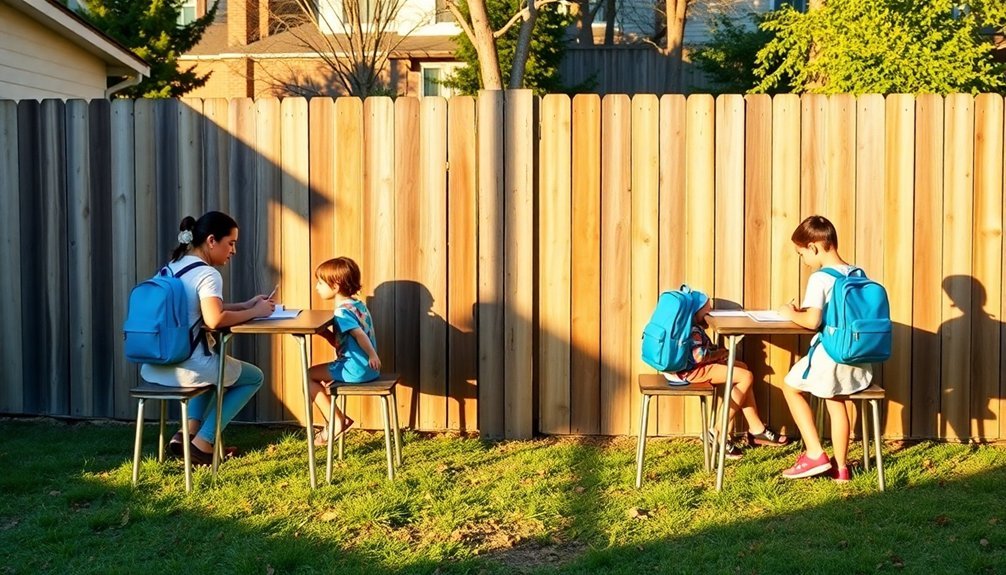Like a skilled tightrope walker maneuvering a precarious wire, you've found yourself balancing the complex dynamics of co-parenting with a high-conflict ex. You're not alone in seeking a way to protect your peace while ensuring your children's well-being remains the top priority. If traditional co-parenting methods have left you exhausted and frustrated, parallel parenting might be the structured approach you need to regain control. This alternative method offers a practical framework for managing your parenting responsibilities while minimizing direct contact with your ex-partner, and there's much more to discover about making it work effectively for your family.
Key Takeaways
- Parallel parenting minimizes direct contact between high-conflict ex-partners while maintaining separate households and structured communication focused on children's needs.
- Business-like communication through emails and apps replaces emotional exchanges, reducing conflict and establishing clear documentation trails.
- Detailed parenting plans outline schedules, routines, and decision-making protocols to prevent conflicts and ensure consistency for children.
- Using third-party intermediaries and dedicated co-parenting apps helps manage schedules and exchanges without direct interaction.
- Supporting children through transitions with comfort items and predictable routines helps maintain emotional stability during custody exchanges.
What Is Parallel Parenting
Parallel parenting serves as a unique co-parenting approach in which high-conflict ex-partners disengage from direct interaction while maintaining their children's best interests. This method allows you to detach from emotionally charged situations with your ex-partner while still being fully present in your children's lives.
Unlike traditional co-parenting dynamics, parallel parenting minimizes direct contact between parents, replacing it with structured, business-like communication focused solely on essential child-related matters. You'll communicate through email, text, or parenting apps, documenting all interactions and avoiding face-to-face meetings whenever possible.
The parallel parenting benefits extend beyond reduced conflict. You'll create clear boundaries, maintain separate households with distinct rules, and attend children's events independently.
This approach helps shield your children from parental tensions while ensuring they maintain meaningful relationships with both parents. Your children won't feel caught in the middle of adult conflicts, and you'll have the space to heal and focus on positive parenting within your designated time.
Think of it as running two separate households that coordinate only when absolutely necessary for your children's wellbeing.
Signs You Need This Approach

You'll know it's time to contemplate parallel parenting when you notice a persistent pattern of hostile exchanges and unproductive communication with your co-parent.
If you've tried traditional co-parenting methods but continue to face toxic behaviors, manipulation, or constant undermining from your ex-partner, these are clear indicators that a different approach is needed.
When standard co-parenting strategies have repeatedly failed despite your best efforts, parallel parenting can offer a structured alternative that protects both you and your children from ongoing conflict.
Constant Hostile Communication Pattern
Hostility and antagonism in co-parenting communications often signal the need for a more structured approach. You might notice that every interaction with your ex-partner turns into an argument, even when discussing simple matters like schedule changes or school events.
These hostile interactions can leave you feeling drained, frustrated, and unable to focus on your child's needs.
When you're experiencing constant communication breakdowns, you'll likely see patterns such as immediate defensive responses, accusations in every email, or texts filled with blame and criticism.
You might find yourself dreading every notification from your co-parent or avoiding necessary conversations altogether. If you notice that civil discussions have become impossible, and every exchange escalates into conflict, you're dealing with a hostile communication pattern.
You're not alone if you feel trapped in this cycle. Many co-parents face similar challenges, and recognizing these patterns is the first step toward change.
When basic conversations become battlegrounds, and you can't maintain a respectful dialogue about your children's needs, it's time to contemplate parallel parenting as a protective strategy.
Toxic Co-Parent Behavior Persists
Beyond hostile communication patterns, specific toxic behaviors from your co-parent can signal that parallel parenting isn't just helpful—it's necessary.
When your co-parent consistently undermines your parenting decisions, bad-mouths you to the children, or uses them as messengers, these actions reveal deeply problematic co-parent dynamics that require immediate boundaries.
You might notice your co-parent deliberately scheduling conflicts with your parenting time, refusing to share important information about the children's activities, or making unilateral decisions about medical care or education.
They may also manipulate your children's emotions against you or violate court-ordered arrangements repeatedly.
These toxic behaviors create an unstable environment that affects your children's well-being and your ability to parent effectively.
If you're experiencing these challenges, you're not alone. Many parents face similar struggles with toxic behavior from former partners.
Parallel parenting offers a structured approach that limits direct interaction while maintaining your children's needs as the primary focus.
Failed Standard Co-Parenting
After months or even years of attempting traditional co-parenting, certain warning signs indicate it's time to contemplate a parallel approach.
You've likely experienced mounting frustration as co-parenting challenges continue to escalate despite your best efforts to make it work. Failed expectations and constant conflict can leave you feeling defeated, but recognizing when traditional methods aren't serving your family is actually a step toward positive change.
You might be ready for parallel parenting if you notice these clear indicators:
- Your attempts at direct communication consistently result in arguments, blame-shifting, or emotional manipulation.
- You've experienced repeated cancellations, schedule changes, or other disruptions that affect your children's routine.
- Your children show signs of stress or anxiety when witnessing interactions between you and your co-parent.
- You find yourself dreading every exchange, phone call, or required interaction with your former partner.
Setting Clear Communication Boundaries

To protect yourself and maintain clear records in parallel parenting, you'll need to establish structured communication rules from the start.
Using a business-like email format keeps interactions professional and focused, while ensuring all agreements, schedules, and decisions are documented in writing prevents future misunderstandings.
It's important to create a specific protocol for genuine emergencies, including acceptable contact methods and expected response times, so both parents know exactly how to handle urgent situations involving your children.
Use Business-Like Email Format
When communicating with a high-conflict co-parent, maintaining professional boundaries through a business-like email format helps reduce emotional triggers and misunderstandings.
Like any business correspondence, your emails should be clear, focused, and free from emotional language to promote effective communication and conflict resolution.
Structure your co-parenting emails following these professional guidelines:
- Subject Line: Use specific, clear subjects like "Pick-up Time Change Request – [Child’s Name] – [Date]" to maintain organized communication threads and set a businesslike tone.
- Opening: Start with a neutral greeting such as "Good morning" or simply their name, avoiding personal or informal salutations.
- Body Content: Present facts only, use bullet points when possible, and stick to one topic per email to prevent confusion or escalation of conflicts.
- Closing: End with a professional signature like "Regards" or "Thank you," followed by your name.
Document Everything in Writing
Building on the business-like communication approach, maintaining detailed written records protects both parents and children in high-conflict co-parenting situations.
When you're documenting interactions with your co-parent, focus on facts rather than emotions, and include dates, times, and specific details of all exchanges and agreements.
Create a dedicated folder or digital system to store all written communications, including emails, text messages, and any written agreements you've made.
You'll want to save records of schedule changes, medical decisions, school-related matters, and any modifications to existing arrangements. This organized documentation can prove invaluable if disagreements arise or if you need to demonstrate patterns of behavior.
Remember to confirm verbal conversations through follow-up emails, starting with phrases like "As discussed" or "To confirm our conversation."
This practice guarantees both parties have the same understanding of what was agreed upon.
When documenting incidents or concerns, stick to observable facts and avoid interpretations or accusations.
Your goal isn't to build a case against your co-parent but to maintain clear, accurate records that support your child's best interests.
Establish Emergency Contact Protocol
Clear boundaries around emergency communications lay the foundation for effective parallel parenting. When you're dealing with a high-conflict co-parenting situation, it's essential to establish specific protocols for genuine emergencies while maintaining emotional distance.
You'll need to define what constitutes an emergency and set up dedicated communication channels that both parties agree to use.
Create an emergency contact protocol that includes these vital elements:
- Define true emergencies (medical situations, school-related urgencies, safety concerns) and distinguish them from non-emergency matters.
- Establish primary communication channels (specify whether to use phone calls, texts, or a co-parenting app) for emergency situations.
- Create a list of approved emergency contacts, including medical providers, school officials, and trusted family members.
- Set clear response time expectations (for example, responding within 30 minutes for medical emergencies).
Remember that your emergency protocol should be in writing and shared with all relevant parties.
This structured approach helps reduce anxiety and prevents the misuse of emergency channels for non-urgent matters. When both parents understand and follow these guidelines, you're better equipped to handle critical situations while maintaining appropriate boundaries.
Creating Detailed Parenting Plans

A detailed parenting plan serves as the foundation for successful parallel parenting, acting as your roadmap for guiding daily decisions and potential conflicts. When creating your plan, you'll need to address every aspect of your child's life with specific, unambiguous language that leaves little room for interpretation or disagreement.
Start by outlining detailed schedules for regular routines and special occasions. Your plan should include clear conflict resolution procedures and specific guidelines for decision-making in various situations.
| Area | What to Include | Why It Matters |
|---|---|---|
| Schedule | Pick-up/drop-off times | Prevents scheduling conflicts |
| Education | School choice, activities | Maintains academic stability |
| Healthcare | Medical decisions, insurance | Guarantees prompt care |
| Holidays | Rotation schedule, times | Reduces annual disputes |
| Communication | Method, frequency, topics | Sets boundaries clearly |
Remember to include provisions for technology use, social media posting guidelines, and methods for sharing important documents. You'll also want to specify how to handle schedule changes, extracurricular activities, and emergency situations. Consider including a review period where you can assess the plan's effectiveness and make necessary adjustments through proper legal channels.
Tools For Minimal Contact

Three essential tools make minimal contact both manageable and effective in parallel parenting situations.
When you're handling a high-conflict co-parenting relationship, implementing minimal interaction strategies helps maintain boundaries while ensuring essential communication about your children continues smoothly.
For effective boundary setting and peace of mind, you'll want to utilize these proven communication tools:
- A dedicated co-parenting app that documents all exchanges, tracks schedules, and stores important information about your children's activities, medical appointments, and school events.
- Email-only communication with a 24-hour response window, focusing solely on child-related matters using a business-like tone and the BIFF method (Brief, Informative, Friendly, Firm).
- A neutral third-party intermediary for exchanges when face-to-face contact creates tension.
- A shared online calendar that both parents can access, eliminating the need for direct communication about schedule changes or activities.
These tools create a protective buffer while ensuring you're meeting your children's needs.
Protecting Your Mental Wellbeing

While establishing structured communication tools helps manage external conflicts, safeguarding your emotional health requires equal attention. As a parallel parent, you'll need to develop emotional resilience to navigate the ongoing challenges of high-conflict co-parenting.
Start by building a strong support network of friends, family, or a therapist who understands your situation. You're not alone in this journey, and having people who can validate your experiences makes a significant difference.
Implement self care strategies that work for you, whether it's regular exercise, meditation, or pursuing hobbies that bring you joy.
Set clear emotional boundaries by practicing mindfulness when triggering situations arise. You don't need to absorb negative energy or respond to every provocation. Instead, focus on what you can control – your reactions, your parenting time, and your personal growth.
Consider joining support groups where you can connect with others in similar situations and share coping mechanisms.
Remember that protecting your mental wellbeing isn't selfish – it's essential. When you're emotionally stable, you're better equipped to provide the consistent, nurturing environment your children need during this challenging time.
Supporting Children Through Transitions

Regular shifts between households can be emotionally taxing for children in parallel parenting situations. Your role in maintaining child emotional stability during these changes is vital, even when co-parenting communication is minimal.
You can create a supportive environment that helps your children develop effective coping strategies for transitions while respecting parallel parenting boundaries.
To help your children navigate between households more smoothly, consider implementing these proven approaches:
- Pack a comfort item that travels between homes – like a special stuffed animal or blanket – to provide consistency and security.
- Maintain a predictable routine for transition days, including set preparation times and familiar goodbye rituals.
- Create a visual calendar they can reference to know when they'll be at each parent's house, reducing anxiety about schedule changes.
- Establish a quiet, welcoming re-entry routine for when they return to your home, allowing them to decompress and readjust.
Remember that your calm, steady presence helps your children feel secure during changes.
While you can't control what happens in the other household, you can provide stability and emotional safety in yours, helping your children build resilience over time.
Frequently Asked Questions
How Long Should Parallel Parenting Arrangements Typically Last?
There's no one-size-fits-all duration for your parenting arrangement, as it depends on several key flexibility factors.
You'll want to assess your situation periodically, considering how communication and conflict levels evolve between you and your co-parent.
Duration considerations should focus on your child's needs and developmental stages.
You can adjust the arrangement as relationships improve or maintain it long-term if needed – what matters most is creating stability for your child.
Can Parallel Parenting Affect Child Support or Custody Agreements?
Just like adjusting the sails on a boat doesn't change its destination, parallel parenting doesn't directly alter your existing child support or custody arrangements.
However, if you're consistently documenting communication and parenting challenges, you might've grounds for custody modifications.
What Age Is Best to Start Parallel Parenting?
You'll want to reflect on your child's developmental stages when deciding the right time to start.
While there's no single "perfect" age, children from preschool age (3-5) and up can generally adapt well to this arrangement.
Your child's emotional maturity and ability to understand routines are key age factors.
You can start when you notice your child can handle changes between homes and maintain a sense of security with both parents.
Should New Partners Be Included in Parallel Parenting Communications?
Like building a fortress around precious cargo, you'll want to maintain clear communication boundaries between co-parents.
It's best to keep new partners out of direct parenting communications – they can support you behind the scenes, but partner involvement in exchanges should be minimal.
You're creating a focused channel strictly for child-related matters between parents.
If you need emotional support during interactions, lean on your partner privately while keeping official communications parent-to-parent only.
Can Parallel Parenting Evolve Into Cooperative Co-Parenting Over Time?
Yes, you can shift from parallel parenting to cooperative co-parenting over time.
As both parents develop better communication strategies and demonstrate consistency, you'll often find that tensions naturally decrease.
Start with small, gradual shifts – maybe sharing positive updates about your child or acknowledging each other's parenting wins.
Conclusion
Walking the parallel parenting path isn't just about survival – it's about thriving despite the storms. You're taking control of your well-being and your children's future by choosing this structured approach. Remember, every boundary you set and every detailed plan you create brings you closer to peace. While it won't always be easy, you're building a foundation that'll support both you and your children through this journey.





0 responses to “Parallel Parenting: Your Lifeline in High-Conflict Situations”
Parallel parenting sounds good in theory, but isnt it just avoiding the real issues? It seems like a temporary fix rather than a solution.
Is it just me, or does parallel parenting sound like a band-aid solution to an unresolved communication issue? Thoughts?